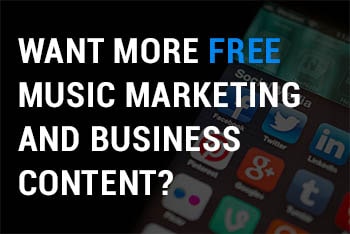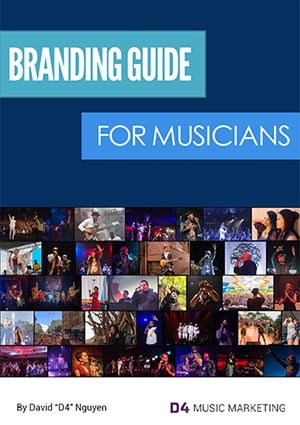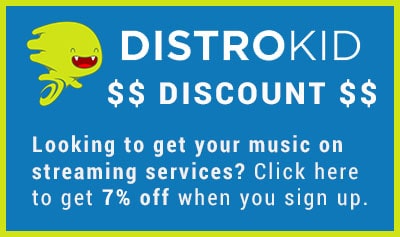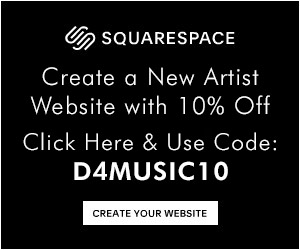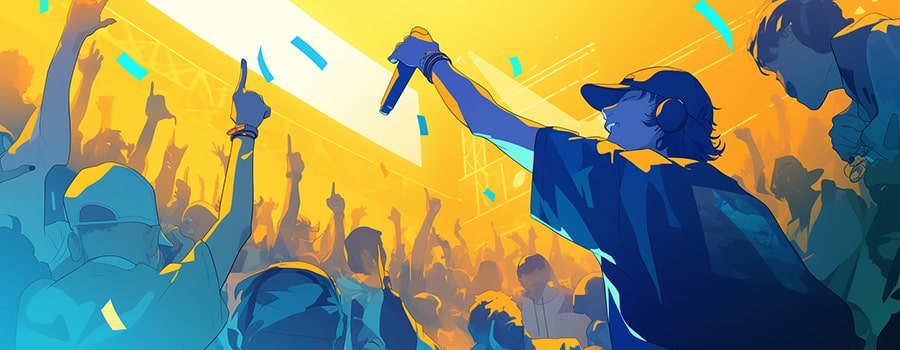
Live performance is often the most important revenue source for an independent artist. It is in your best interest to promote your shows and draw a crowd, no matter what stage of your career you are in or how established you are.
When working with agents, promoters, talent buyers and venues, you always want to make sure to make a good impression to build those business relationships. Not only by being professional but by doing everything you can to sell out the show.
In this blog, I’ll cover 12 ways you can announce and promote your upcoming shows and tours.
1. Bandsintown / Spotify Integration
The first place that I go to when a show is confirmed is to add on Bandsintown.
Bandsintown has been the go-to live music directory for many years now. Fans can track/follow their favorite artists and get email notifications when a show is announced in their city.
From my experience, it has become the standard platform for musicians to list their live shows. You can also add a widget to your website that will automatically have all your shows listed from Bandsintown on to your website.
You can also send geo-targeted messages to fans who track you to follow up with reminders or special offers.
Bandsintown now has a Spotify integration that allows your shows and events to be displayed in the Spotify app. Fans will get notifications in-app and via emails from Spotify as well.
2. SongKick
SongKick is also a concert discovery service, but it is owned by Warner Music Group. They used to be the main live show platform for Spotify, but that 13 year relationship ended with the new Bandsintown integration.
SongKick may not be as important moving forward for newer artists. For established artists, you may still have fans that use the platform so it doesn’t hurt to list your upcoming shows and tours there.
3. Email Marketing
If you have an email list (and you should), you’ll want to send out a newsletter to get the word out.
If you can geo-target your fans by city, then that would be the most ideal. There’s no point in announcing a show in a particular city if you have fans all over the country.
Otherwise, you’ll want to announce a group of shows together rather than emailing them about individual shows.
Some email marketing tools will use IP addresses to help you determine where your fans are located, but it may not always be reliable. Something you can implement is having a question about what city they’re located in when signing up for your newsletter.
4. Social Media
Promoting your shows on social media is the standard and bare minimum that is expected of you as the artist. You should do this on all platforms you’re active on. For example on Instagram, you can make the announcement with a standard post, Reels, Stories and a Broadcast channel message.
The problem with social media is that the algorithms generally don’t like these types of posts, especially if it is just a standard flyer with text on it.
The next best thing is to do a selfie-style video or share a short performance clip to promote the show. This is way more personable and engaging than a flyer.
If you can capture good audio in a setting with a nice background, you can try doing a livestream performance as a way to promote your tour. Once it’s done, download the livestream video and chop it up into shorter clips to post. Leave some white space in case you want to add text overlays. This is a great way to repurpose your content.
Lastly, consider creating a skit or a fun advertisement video if it makes sense for your brand or personality. This is a trend I see more artists are doing over the years. It requires more thought, time and energy, but at least providing entertainment value helps to get more views on it.
Some other tips:
If you post on Facebook, be sure to include the ticket link in the post itself or add a comment with the ticket link.
If you post on other platforms where you can’t include the ticket link, add it to your “link in bio” or micro website (i.e. LinkTree or Beacons). You can also use a chat automation service like ManyChat to DM your fans a link to buy tickets if they leave a specific comment like TICKETS.
On Instagram, create a Story and include a link sticker for tickets and tag the venue so they can reshare. You may also include the location tag for the city the show is in.
5. Paid Socials
Venues and promoters will have a budget to market and promote each show. Typically, this is done through their own channels and social accounts. They may request advertising access to your Meta properties, but it doesn’t hurt if you run ads to your fans directly from your own account.
Since posts that sell something may see lower organic reach on socials, you should put some money behind the announcement post and have it geo-targeted to the city the show is in. For an independent artist, $50 to $200 is a reasonable amount to spend.
6. Facebook Events
Depending on the demographic of your fanbase, you may consider creating a Facebook Event for your upcoming show. Younger demographics likely don’t use Facebook regularly so it may not be as effective if your music leans more on the “youthful” side.
However, with over 3 billion active monthly users, Facebook is still the number one social media platform globally. Facebook Events is a free service with a wide reach and can recommend shows to users through its algorithm. The event page has an RSVP system that allows fans to see people they know in their network who are interested or going.
7. Pandora AMP Audio Messages
For those fans who use Pandora, you can leave a short, geo-targeted audio message in between your songs to promote a show. When you set up a campaign for each individual show, you can include a clickable ticket link for fans to purchase tickets directly from the app.
Claim your Pandora Artist Profile or log into your Pandora AMP account to get started.
8. SMS Marketing
If you’re already paying for a short messaging service (SMS), like Community or SuperPhone, you’ll want to send out geo-targetted texts out to your fans when there’s a show in their city. Depending on the service, you can also target fans within a specific mile radius of a city.
In my experience, SMS is very effective for promoting shows. Since it goes directly to people’s phones, you see higher open and conversion rates.
The drawback is you have to be careful with how many texts you send over a certain period as you don’t want to annoy your fans. More importantly, SMS marketing services can be quite expensive.
9. Local Media
Local media outlets may offer ways to announce or list shows in your city. Outlets to look out for are city newspapers (with arts and entertainment sections), community and college radio stations, magazine publications, music blogs, and local TV stations.
If you have a publicist, see if they can do this for you, especially if you have a tour in multiple cities.
10. Local Online Communities
Check if there are local online communities that allow you to promote an upcoming show. This could be on a specific subreddit for a specific city or local music community. You can also check Craigslist.
If you know of fan-created online communities, like on Reddit, Discord or a Facebook Group, that’s something to consider. Dedicated fans of these communities will likely share new show or tour announcements on their own.
11. Fan Membership Platforms
If you already have fans on a membership platform like Patreon, you should be prioritizing your show announcements there.
For some of the Patreon pages I’ve set up, one of the perks we offered is early access to all things related to the artist. For shows and tours, this means sharing the pre-sale code to Patreon before the general public.
12. In-Person Flyering and Postering
Lastly, you have the old-school way of promoting your shows. Before the internet, you would have street teams that would hand out flyers in person and put up posters around the city. For independent artists, this was your main method to get the word out about your shows.
In this digital age, flyering and postering are not very common. Assuming you already have a fan base and some traction in a local city, this can still be a viable option. You’ll want to focus on areas, buildings, businesses and even other concerts that your target audience or fan base would most likely be in.
Conclusion
The goal for every artist should be to perform in front of a sell out crowd. To make that happen, make sure to utilize all your different options and do your part to promote your live shows and tours. You want to leave a good impression so you’re more likely to be booked again in the future.
After all, a show with a low turnout can reflect poorly on your reputation with venues and promoters. But whatever you do, be sure to avoid these live performance mistakes.



